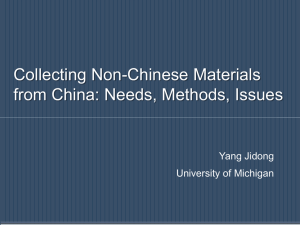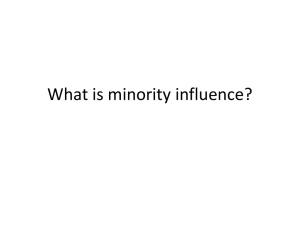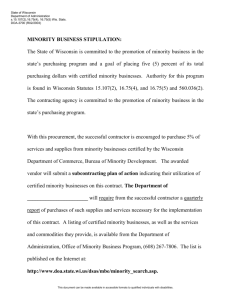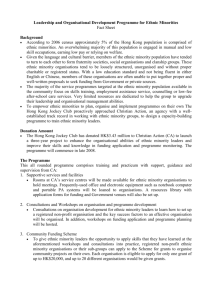Ethnic representation in the current Chinese leadership
advertisement
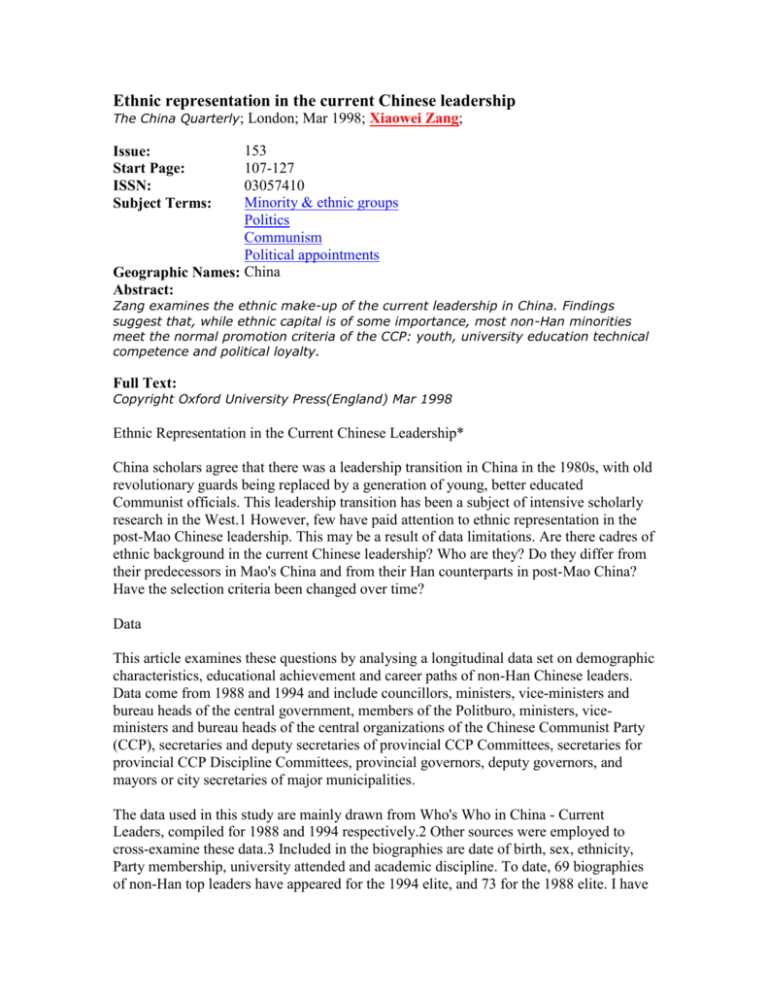
Ethnic representation in the current Chinese leadership The China Quarterly; London; Mar 1998; Xiaowei Zang; 153 107-127 03057410 Minority & ethnic groups Politics Communism Political appointments Geographic Names: China Abstract: Issue: Start Page: ISSN: Subject Terms: Zang examines the ethnic make-up of the current leadership in China. Findings suggest that, while ethnic capital is of some importance, most non-Han minorities meet the normal promotion criteria of the CCP: youth, university education technical competence and political loyalty. Full Text: Copyright Oxford University Press(England) Mar 1998 Ethnic Representation in the Current Chinese Leadership* China scholars agree that there was a leadership transition in China in the 1980s, with old revolutionary guards being replaced by a generation of young, better educated Communist officials. This leadership transition has been a subject of intensive scholarly research in the West.1 However, few have paid attention to ethnic representation in the post-Mao Chinese leadership. This may be a result of data limitations. Are there cadres of ethnic background in the current Chinese leadership? Who are they? Do they differ from their predecessors in Mao's China and from their Han counterparts in post-Mao China? Have the selection criteria been changed over time? Data This article examines these questions by analysing a longitudinal data set on demographic characteristics, educational achievement and career paths of non-Han Chinese leaders. Data come from 1988 and 1994 and include councillors, ministers, vice-ministers and bureau heads of the central government, members of the Politburo, ministers, viceministers and bureau heads of the central organizations of the Chinese Communist Party (CCP), secretaries and deputy secretaries of provincial CCP Committees, secretaries for provincial CCP Discipline Committees, provincial governors, deputy governors, and mayors or city secretaries of major municipalities. The data used in this study are mainly drawn from Who's Who in China - Current Leaders, compiled for 1988 and 1994 respectively.2 Other sources were employed to cross-examine these data.3 Included in the biographies are date of birth, sex, ethnicity, Party membership, university attended and academic discipline. To date, 69 biographies of non-Han top leaders have appeared for the 1994 elite, and 73 for the 1988 elite. I have also collected 688 biographies of top Han Chinese leaders in 1988 and 834 biographies in 1994. To the best of my knowledge, this is the most extensive biographical data set of ethnic representation in the post-Mao Chinese leadership. This article compares the nonHan leaders with both their predecessors in Mao's China and their Han counterparts in post-Mao China. Finally, elites are powerful because they control powerful organizations. Thus, most scholars adopt a "positional approach" to study them. Elitehood is defined by positions in the power hierarchy.4 I follow this approach in this research. In the coding process I treated each case as a person-position, so that, for example, a provincial governor who is also a deputy provincial Party secretary would be represented by two separate observations, one for each post. Minorities Elites before the 1980s According to June Dreyer, the first group of the minority Communist "pioneers," such as Ulanfu of Mongolian origin, were similar to the initial Han recruits to the Communist cause. They joined the CCP or the Red Army in the 1920s and were from upper or upper middle class families, generally urban-oriented and well educated.5 However, their number was small and they did not become top leaders. For example, the first five Central Committees of the CCP included no minority cadres. In the CCP's Sixth Congress in 1928, Guan Xiangying, a Manchu, was selected into the Sixth Central Committee of the CCP. Guan also became a member of the Central Executive Council of the Jiangxi Soviet in the early 1930s. When Deng Xiaoping and Zhang Yunyi staged a military uprising in Guangxi they recruited a number of Zhuang nationals to the Red Army. The best known of them was Wei Pocheng, who also became a member of the Central Executive Council of the Jiangxi Soviet in the early 1930s.6 However, overall there was little ethnic representation in the top Communist leadership positions during this period. This may be because the Communist revolution in this stage occurred mostly in areas, such as Shanghai and Jiangxi, where there were not many minority people. Ethnicity was not a political issue for the CCP. When the Red Army passed through minority areas during the Long March, some members of various ethnic groups, such as Hui, Yi and Tibetans were recruited into the Red Army. This second group was quite different from the first: they were from poor families and illiterate. Their level of political awareness was low and they did not even understand Chinese.7 An example of the second group is the Tibetan Zhaxi Wangqug. He was born in Sichuan province in 1913 and joined the Red Army in 1935. He took part in the Long March, became a CCP member in 1938, and held various low and middle military and government positions before 1949. Among many other posts, he was appointed deputy governor and later provincial Party secretary of Qinghai province between 1949 and 1981.8 After the Long March, recruitment of minorities was carried out by the CCP in the Shaanxi-Gansu-Ningxia border region. The majority of the recruits were Hui and Mongols. Minority youth from other areas also joined the CCP. For example, the Mongolian Kong Fei, who was born in 1911, a native of Horqin Left Wing Middle Banner, Inner Mongolia, participated in the December Ninth Movement in 1935. He joined the CCP in 1936 and went to Yan'an to study in the Anti-Japanese Military and Political University. He held various military and government positions before 1949, and between 1949 and 1983 - among many other posts became deputy commander-in-chief of the Military Region Command of Inner Mongolia, provincial CCP secretary, and governor of Inner Mongolia Autonomous Region.9 Another example is the Hui Ma Yuhuai, who was a native of Renqiu county in Hebei province and joined the CCP in 1938. From 1949 to 1982 he held many leadership positions, including deputy governorship of Ningxia Hui Autonomous Region and vice-minister of the Forestry Ministry under the State Council.10 By the time of the 1949 liberation, the CCP had trained a number of leaders from ethnic backgrounds to work for Chinese socialism in minority areas. The CCP also transferred many minority cadres who had been engaged in direct political and military struggles against the Kuomintang (KMT) to do minority work after the establishment of the PRC (including both Zhaxi Wangqug and Ma Yuhuai). In addition, the CCP allowed traditional leaders of the minorities who were willing to corporate with the new regime to stay in office.11 As Dreyer points out, these measures were adopted because historically there had been distrust between Han Chinese and minorities. Further, minority areas were characterized by illiteracy and economic backwardness and had been virtually untouched by modern ideas. The CCP recognized that such areas had their own characteristics and believed that the solution to the nationalities problem lay in training a large number of cadres from ethnic backgrounds in minority areas. Accordinglv. the Party sought such qualified cadres to take leading positions in the CCP and government hierarchies in minority areas. In a sense, this was a kind of affirmative action policy in elite recruitment because these cadres, with few exceptions, could not possibly match the CCP seniority, theoretical sophistication and revolutionary experience of Han cadres. Their value was in their potential appeal to their ethnic groups. According to June Dreyer, by the early 1960s, in Ningxia Hui Autonomous Region, three out of six provincial secretaries and deputy secretaries were Hui. In Inner Mongolia four out of five Party secretaries and deputy secretaries were Mongols and the first Party secretary was Ulanfu. In Guangxi Zhuang Autonomous Region, two out of six Party secretaries and deputies were Zhuang. Its governor and first Party secretary was Wei Guoqing, a Zhuang. Xinjiang also had a Uygur deputy secretary. Nationalities Affairs Commissions at both the central and local levels were to a great degree staffed by nonHan cadres. In Tibet and other minority areas (such as Xinjiang) some traditional leaders (such as Panchen Lama and Ngapo Ngawang Jigme) were appointed leaders of local governments. Most minority activists recruited by the CCP after 1949 were however placed below the district level in the CCP and government hierarchies. They had little prospect of success outside the CCP or government minorities work bureaus, or outside their own minority areas.12 During the Cultural Revolution, some minority leaders, such as Ulanfu, were briefly purged and then rehabilitated. Others, such as Wei Guoqing, first secretary of Guangxi Zhuang Autonomous Region, and Saifudin, deputy secretary of the Xinjiang Uygur Autonomous Region, remained in office undisturbed. During the Cultural Revolution, as a rule, minority names appeared on a list of a provincial revolutionary committee in rough proportion to the population strength of the minorities in that province.13 This indicates their symbolic value ("ethnic capital") to the CCP's minority policy regardless of whether or not they might wield power in their functions. Even during the chaotic period of the Cultural Revolution, ethnic capital was important in elite recruitment in regions with significant minority populations. Finally, in 1978 only 1.5 per cent of cadres at the county, prefectural and municipal levels in China had received a college education.l4 The educational level of minority cadres was presumably much lower as minorities were much less educated than Han Chinese. It can be argued that the vast majority of leaders of ethnic background before the 1980s were revolutionary cadres with little educational achievement. They had been trained in politics and minority affairs and had rich experience in revolution and minority affairs. Ethnic Representation in the Post-Mao Chinese Leadership Demographic characteristics. The importance of ethnic capital has not diminished in cadre appointments in post-Mao China. Table 1 shows that in 1988 and 1994 the Han representation in the Chinese leadership was in rough proportion to the Han population (about 91 per cent). Table 1 also indicates that Tibetans, Mongolians, Uygur, Zhuang and Hui fare better than other minorities in providing candidates to top leadership positions. Their numerical representation in the top leadership was consistent in 1988 and 1994. However, the numerical strength of a minority group is not necessarily correlated with the number of cadres. For example, 1.4 per cent of China's population in 1990 were Zhuang, but their representation in the Chinese leadership was 0.8 per cent in 1988 and 0.6 per cent in 1994. On the other hand, 0.4 per cent of China's population in 1990 were Tibetans, but they produced 2.2 per cent of the total top leaders in 1988 and 1994. Table 2 indicates that all minority leaders were promoted after 1978 and are the product of the post-Mao leadership transition. Their turnover rate is fairly high. For example, 15 of the 1988 minority cadres were promoted in 1988, but by 1994 only three of them were still in office. This suggests that minority cadres are not cultivated as leadership candidates by the CCP. Table 3 shows that cadres of minority status are under-represented at the central government level. For example, only 5.3 per cent of ministers in 1988 were from minorities. In both 1988 and 1994 all bureau heads were Han cadres. However, non-Han leaders are over-represented in provincial governments. For example, in 1988, 21 per cent of deputy secretaries and 14.6 per cent of deputy governors were cadres from minority backgrounds. Further, ethnic capital in elite recruitment in China has mainly benefited non-Han male cadres. There has not been an affirmative action for women regardless of their ethnic origins. This is no surprise because the emphasis of ethnic capital is on ethnicity, not gender. Table 4 shows a persistent bias against recruiting women into top leadership positions across time and ethnic group. In 1988, 94.8 per cent of Han leaders and 95.7 per cent of minority leaders were male. In 1994, again, 94.5 per cent of Han leaders and 95.9 per cent of leaders of ethnic background were male. Table 5 shows the distribution by age group and the average age for Han and non-Han Chinese leaders. The age of non-Han leaders varies more than that of Han leaders, but the difference in average age between the two groups is not very great. In 1988, the average age of Han leaders was 56.8 and of non-Han leaders was 55.2. In 1994, the equivalent ages were 57 and 55.6. Table 6 shows the geographic origins of non-Han leaders in 1988 and 1994. Not surprisingly, a significant proportion are from Inner Mongolia, Tibet, Xinjiang and Qinghai, where many minorities (especially Uygur, Kazak, Tibetans and Mongolians) reside. Ningxia and Guangxi also contain significant numbers of minorities (especially Hui and Zhuang), but their performance in elite recruitment is poor compared to that of the above-mentioned four autonomous regions/provinces. This contrast is impressive because Hui and Zhuang outnumber Uygur, Kazak, Tibetans and Mongolians significantly (see Table 1). The relatively poor performance of Ningxia and Guangxi may be because the Hui and Zhuang are very sinicized and cannot be readily distinguished from the Han in terms of physical appearance, clothing and language. They may not have the same amount of the symbolic value of national ethnic unity as those from other minority regions. This fact may also explain why Yunnan, as compared with Ningxia, did quite well in sending non-Han people into top leadership positions in 1988 and 1994. The numerical strength of each of Yunnan's major minorities (especially Yi, Dai, Bai and Li) is far weaker than that of the Hui (see Table 1). But because of the salient differences in clothing and languages between Han and Yunnan's minorities, Yunnan's non-Han cadres seem to possess more ethnic capital than Hui cadres in Ningxia, who are much more sinicized. Ethnic capital in elite recruitment in China acts in favour of the minority groups that have strong ethnic identities. Table 6 also shows that the total population strength of minority groups in a province, municipality or autonomous region is not necessarily related to the number of the top leaders it produces. For example, 38.6 per cent of Guizhou' s population belong to various minority groups, but none of them was represented in the top leadership positions in 1994. In contrast, 22.8 per cent of Inner Mongolia's population were members of ethnic minorities and 13.7 per cent of the top leaders in 1994 were from this autonomous region. A minority group needs to be numerically strong as well as having a strong ethnic identity to send a fair share of cadres to leadership positions. Most of the minorities in Guizhou have very strong ethnic identities. But each of them is numerically much weaker than Mongolians, most of whom reside in Inner Mongolia, where many minority leaders are produced. Table 7 shows that unlike their Han counterparts, most minority cadres hold leadership positions in their home provinces. More than 68 per cent of the 1988 minority leaders and 65.8 per cent of those in 1994 work in provinces where they were born. This is no surprise since ethnic capital is a local capital. A Mongolian, for example, will not appeal to the Hui in Ningxia and if he or she is appointed a leader his or her office must be in Qinghai or Inner Mongolia where a significant percentage of the population are Mongolians. Table 8 shows that minority cadres hold leadership positions in 16 provinces. In the remaining 14 provinces where most of the population are Han Chinese, no minority leaders were appointed to leadership positions. Not surprisingly, there are more minority cadres in Xinjiang, Tibet, Inner Mongolia, Yunnan, Guangxi, Ningxia and Qinghai than in other provinces simply because these provinces and autonomous regions have the biggest share of minority populations. Educational attainment and professional titles. Before the Cultural Revolution the most important promotion criterion was political loyalty. Most cadres were revolutionaries with little education. Since the 1980s, however, university education has become one of the most crucial criteria for upward mobility in the power hierarchy. Table 9 shows the educational attainment of the top Chinese leaders. In both 1988 and 1994 Han leaders were better educated than non-Han leaders. However, the difference in educational achievement between the two groups was reduced significantly over the six years, mostly because of the great improvement in the educational background of the non-Han leaders. In 1988, for example, only 37.6 per cent of the non-Han cadres received university education. This figure rose to 63 per cent in 1994. The educational levels of Han cadres also increased significantly between 1988 and 1994, but the increase was not as great as that for non-Han cadres. Table 10 shows the universities attended by minority leaders. Only 11.5 per cent of the 1988 minority leaders and 13.7 per cent of the 1994 minority leaders received their college education in Party schools or nationalities institutes. Most were educated in normal universities or colleges, including China's best universities such as Beijing Medical University, Beijing University, Jinlin University, Nankai University, People's University and Qinghai University. Moreover, one of the 1988 minority leaders and five of those in 1994 received their degrees from overseas universities. Table 11 shows the academic majors of post-Mao Chinese leaders. There is an increase in the representation of the non-Han cadres trained in "technical fields" (finance/MBA, engineering and construction). In 1988, 17 per cent of the Han cadres and 2.9 per cent of the non-Han cadres had university degrees in engineering. Six years later, 11 per cent of the non-Han cadres had majored in engineering while the percentage of the Han cadres with engineering degrees had increased only slightly to 21.3 per cent. Table 11 also shows that not many minority leaders majored in politics and Marxism. Only 4.3 per cent in 1988 and 8.2 per cent in 1994 had received their degrees in these political fields. Table 12 shows that in 1988, 35.5 per cent of the Han leaders and 17.4 per cent of the non-Han leaders held various professional titles. In 1994, the equivalent figures were 34.4 per cent and 24.7 per cent. The difference in professional achievement between the Han and nonHan leaders was reduced over the period 1988-1994. Party seniority and career patterns. Another important criterion for leadership recruitment is political loyalty, often measured by Party membership.'5 Table 13 shows that the vast majority of the minority leaders are Party members. Only one of the 69 minority leaders in 1988 (1.4 per cent) and two of the 73 in 1994 (2.7 per cent) were not Party members. Party membership seniority can be another measure of political loyalty.'6 Table 13 shows that the average Party seniority for the Han leaders was 34.2 years in 1988 and 31.6 years in 1994; for the minority leaders, 32 years and 30.4 years respectively. The distribution of years of Party entry for the Han and non-Han leaders is not very different. Table 14 shows the distribution of career patterns among the Han and the non-Han leaders. More than 46.9 per cent of the Han leaders had work experience in technical fields (engineering, finance and industrial bureau) in 1994; for the minority leaders the figure was nearly 28.8 per cent. Additionally, 11.6 per cent of the 1988 Han leaders and 10.3 per cent of the 1994 Han leaders worked in universities or research institutes, whereas for the minority leaders the figures were 5.7 per cent in 1988 and 15.1 per cent in 1994. Finally, 17.4 per cent of the minority leaders in 1988 and 2.7 per cent in 1994 had experience in minority affairs. In sum, although ethnic capital has been an important asset in elite recruitment in China, non-Han cadres will not be promoted purely on the basis of their ethnicity. The CCP may reserve certain leadership positions for non-Han cadres for political purposes (such as a way of regulating minority relations in China), but these positions have been filled by minority cadres who increasingly match the CCP's normal recruitment requirement for university education and technical competence. Conclusion The above analysis shows that ethnic capital has been an important asset for leadership recruitment in China. Ethnicity alone, however, cannot guarantee success in elite recruitment in the post-Mao era. Ethnic capital in leadership recruitment has mainly benefited non-Han male cadres. A less sinicized minority group has a better chance of sending cadres of its ethnicity to top leadership positions than a more sinicized one, especially if the former has a bigger population than the latter. Further, this research shows that since the 1980s, the Han and the non-Han top leaders have become increasingly similar in terms of age, gender distribution, Party seniority, career patterns, educational achievement and academic majors. It indicates that the quality of the non-Han cadres has improved over the years and they are more technical than their predecessors in Mao's regime who were mainly trained in politics and minority affairs. Post-Mao minority cadres have been promoted not purely on the basis of their ethnic capital. They meet the promotion criteria of the CCP: youth, university education, technical competence and political loyalty. Such increased technical knowledge and experience on the part of non-Han cadres may be an asset from the Han point of view, it does not help very much in maintaining peace and stability in minority areas. Minority leaders in Mao's China knew their ethnic groups well because they had ruled or carried out political work among their ethnic groups before they took leadership positions. Their job was to maintain peace and political stability in minority areas. They mainly worked in minority affairs offices. In contrast, many current non-Han leaders did not receive training in institutes for nationalities or in the Party schools. Their appeal to their ethnic fellows may not be as high as that of their predecessors in Mao's China. They may therefore be less effective in facilitating reconciliation between minority groups and Han Chinese. The educational quality and professional experience of the non-Han cadres has improved greatly in the post-Mao era, but this improvement may not necessarily be a politically beneficial development for the CCP. [Footnote] 1. A. Goldstein, "Trends in the study of political elites and institutions in the PRC," The China Quarterly, No. 139 (September 1994), pp. 714-730; H. Y. Lee, From Revolutionary Cadres to Party Technocrats in Socialist China (Berkeley: University of California Press, 1991); C. Li, "University networks and the rise of Qinghua graduates in China's leadership," The Australian Journal of Chinese Affairs (July 1994), pp.1-30; Cheng Li and D. Bachman, "Localism, elitism, and immobilism," World Politics (October 1989), pp. 64-94; Cheng Li and Lynn White, "The Thirteenth Central Committee of the Chinese Communist Party: from mobilizers to managers,"Asian Survey (April 1988), pp. 371-399; Cheng Li and Lynn White, "Elite transformation and modern change in mainland China and Taiwan," The China Quarterly, No. 121 (March 1990), pp. 1-35; W. Mills, "Generational change in China," Problems of Communism (November-December 1983), pp. 16-35; T. Wong, "An analysis of the PRC's future elite: the third echelon," Journal of Northeast Asian Studies, No. 2 (1985), pp. 19-37; Xiaowei Zang, "Elite formation and the emergence of the bureaucratic-technocracy in post-Mao China," Studies in Comparative Communism (March 1991), pp. 114-123; Xiaowei Zang, "Provincial elite in post-Mao China," Asian Survey (June 1991), pp. 512-525; Xiaowei Zang, "The Fourteenth Central Committee of the CCP: technocracy or political technocracy?" Asian Survey (August 1993), pp. 787-803. [Footnote] 2. Who's Who in China - Current Leaders (Beijing: Foreign Languages Press, 1989); Who's Who in China Current Leaders (Beijing: Foreign Languages Press, 1994). 3. The following sources were used to check the data presented in Who's Who: Cai Kaisong and Yu Xinfeng et al., Ershi shiji zhongguo mingren cidian (A Dictionary of 20th-Centur, Well-Known Chinese Biographies) (Shenyang: Liaoning renmin chubanshe, 1991); Li Fangshi et dl., Zhongguo renwu nianjian (Yearbook of Important Figures in China) (Beijing: Huayi chubanshe,1990, 1991, 1992,1993,1994); Liu Jintian et al., Lijie2honggong zhongyang weiyuan renming cidian, 1921-1987 (A Dictionary of Members of the Central Committees of the Chinese Communist Party, 1921-1987) (Beijing: Zhonggong dangshi chubanshe, 1992); Wang Xiaopeng et al., Zhongguo yidai zhengjie yaoren (Prominent Politicians in Contemporary China) (Beijing: Zhonggong dangshi chubanshe, 1994); Wei Pingyi et al., Gongheguo yaoren lu (A Dictionary of Important Figures in the PRC) (Changchun: Jilin renmin chubanshe, 1994); Yong Guiliang, Zhongguo dandai shehui huodongjia cidian (A Dictionary of Social Activists in Contemporary China) (Beijing: Xuewan chubanshe, 1990): Zhang Liqun et al., Zhongguo renwu nianjian (Yearbook of Important Figures in China) (Beijing: Zhongguo shehui chubanshe, 1996); Zhang Shengzuo et al., Dandai Zhongguo shaoshuminzu mingren Iu (A Dictionary of Important Minority Figures in Contemporary China) (Beijing: Huawen chubanshe, 1992). 4. See G. William Domhoff, Who Rules America? (Englewood Cliff: Prentice Hall, 1967); G. William Domhoff, Who Rules America Now? (New York: Touchstone, 1983); Kenneth C. Farmer, The Soviet Administrative Elite (New York: Praeger, 1992); Harold Lasswell, Daniel Lerner and E. Easton Rothwell, The Comparative Study of Elites (Stanford: Stanford University Press,1952); Ronald Linden and Bert Rockman (eds.), Elite Studies and Communist Politics (Pittsburgh: University of Pittsburgh Press, 1984); C. Wright Mills, The Power Elite (New York: Oxford University Press, 1956); R. Sca]opino (ed.), Elites in the People's Republic of China (Seattle: University of Washington Press,1972); Michael Useem, The Inner Circle (New York: Oxford University Press, 1984). [Footnote] 5. June Dreyer, "Traditional minorities elites and the CPR elite engaged in minority nationalities work" in Scalopino, Elites. 6. Derek J. Waller, "The evolution of the Chinese Communist political elite, 1931-56," in Scalopino, Elites, p. 49. Also see Liu Jintian, A Dictionary of Members of the Central Committees. 7. Dreyer, "Traditional minorities elites." Also see N. Wales, Red Dust (Stanford: Stanford University Press, 1952); Edgar Snow, Red Star over China (New York: Grove Press, 1961). 8. Who's Who in China 1988, pp. 988-89. 9. Ibid. p. 302. [Footnote] 10. Ibid. p. 492. 11. Dreyer, "Traditional minorities elites." 12. Ibid. pp. 442-43. [Footnote] 13. Ibid. pp. 448-49. 14. Li and White, "The Thirteenth Central Committee." [Footnote] 15. A. Walder, "Career mobility and the Communist political order," American Sociological Review, Vol. 60, No. 3 (June 1995), pp. 309-328. 16. Xiaowei Zang, "Elite transformation and recruitment in post-Mao China," Journal of Political and Military Sociology, (Summer 1998). [Author note] *The Contemporary China Research Centre of City University of Hong Kong provided a travel grant for me to attend the 1997 CASS conference in Adelaide, Australia. I would like to thank Dr. Graeme Lang of City University of Hong Kong for his editorial assistance.
